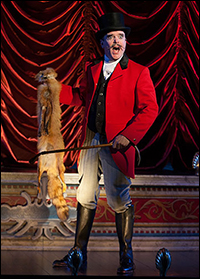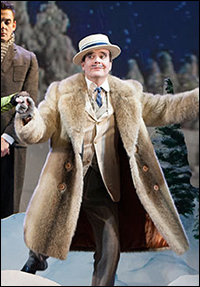
Since most actors would give their eyeteeth for a good death scene, it's easy to fathom why you'll find Jefferson Mays in seventh heaven these days — no, better make that eighth heaven. That's how many times he goes down for the count in A Gentleman's Guide to Love and Murder, Robert L. Freedman and Steven Lutvak's fiendishly funny musical-comedy that began previews Oct. 22, prior to a Nov. 17 bow at the Walter Kerr.
Mays is the moving target in this murderous maze — a centerpiece with the same coat of arms: the D'Ysquiths (pronounced DIE-skwiths) — and he plays all eight of these arrogant English aristocrats who are systematically eliminated by number nine in line, a revengeful rotter after the family fortune named Monty Navarro (Bryce Pinkham).
Navarro was known as Israel Rank in his original incarnation (a book by that name, written in 1907 by Roy Horniman). It's possible that you knew him as Louis Mazzini when Dennis Price played him in that classic British romp, 1949's "Kind Hearts and Coronets" — needless to add, his perforated prey was Alec Guinness-to-the-eighth-power.
Yes, Mays admitted, it is intimidating to follow The Great Guinness — even on a target range — "but the musical is quite a different animal. It's not 'Kind Hearts and Coronets' tonally. And, of course, Guinness had the luxury of prosthetics and makeup to transform himself completely. My transformations are a little more slapdash."
| |
 |
|
| Mays as Lord Adalbert D'Ysquith in A Gentleman's Guide to Love and Murder. | ||
| photo by Henry DiRocco |
On stage, Alexander Dodge's pop-up greeting card-like set provides him with a delightful obstacle course. "It's set in an Edwardian theatre, sort of a stage within a stage, like those toy theatres with the paraffin lamps for footlights and bright, big, color proscenium arches. It's all done in those tones and those colors so there is something jewel-like, toy-like and exquisite that elegantly removes the audience from the actual mayhem and murder that's going on. It's not Sweeney Todd."
| |
 |
|
| Mays as Asquith "Assie" D'Ysquith Jr. | ||
| Photo by Henry DiRocco |
"Lauren plays Phoebe D'Ysquith with a voice like no other — it's a special effect in and of itself," praised Mays, "and Lisa has the Joan Greenwood role, Sibella. It really is a wonderful cast. Bryce has the star part, I suppose, which sorta makes me the serial supporting character — the serial victim.
"My true scene-partner is my dresser. When the producers asked, 'Who do you want dressing you?' I said, 'Oh, please give me Jeeves — someone who shimmers on and just performs magic and shimmers off again, so I don't have to work or think.'"
Darko Tresnjak, artistic director of Hartford Stage who is making his Broadway debut helming this production, is another who keeps Mays on the right character course. "He's an old friend of mine," said the actor. "We worked together at Williamstown and Long Wharf, and he's a joy to work with. We don't talk to each other a lot in rehearsal. We have an odd, sort of telepathic shorthand, which is very much in synch. It's the way I like to work the best. I don't like those rehearsals where everybody is talking things to death and overanalyzing everything."
Consequently, characters keep coming at him like comets all evening long. Eight is enough here, but that is by no means the max for Mays. This is the man, it will be remembered, who won his Tony playing Charlotte von Mahlsdorf, a 65-year-old East German gay transvestite who survived the Nazis and the Communists, living openly as a cross-dresser — plus three dozen other characters — in I Am My Own Wife. In contrast, he happily and heavily sighs, the D'Ysquiths are "just a walk in the park."










